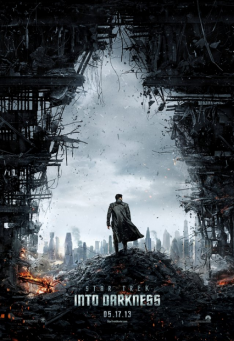Print Edition: May 22, 2013
 The approach of the generation of science fiction re-creator J.J. Abrams is clever above all, dividing its time between pure emotional shorthand, glib referential humour, and earnest evocations of things we like(d), ensuring at worst the work is “not quite as good” as the other thing that last tickled nostalgia, irony, and tearducts in a similar way.
The approach of the generation of science fiction re-creator J.J. Abrams is clever above all, dividing its time between pure emotional shorthand, glib referential humour, and earnest evocations of things we like(d), ensuring at worst the work is “not quite as good” as the other thing that last tickled nostalgia, irony, and tearducts in a similar way.
An eternity of four years has passed since Abrams’ getting-the-team-back-together, and with it apparently has come a desire to move into maturation. Grown out of the detail of television characterization and hyper-attention to series history and how to work it, the main crewmembers (Chris Pine’s James T. Kirk and Zachary Quinto’s Spock) are regarded and view the world with constant scrutiny, making each non-punching non-explosion scene an act of analysis. “When are you ever going to grow up?” is a pointed question to headline an early scene of checklisted faults (the Star Trek movies as a whole feel like the most fun, rigorous checklists in mostly charted space), and as if to answer, Abrams has added comment to his previously isolated, safe method of narrative.
Representation and refresh of the world are a venerated facet of science fiction, but in Abrams’ hands it is both inconsistent and forgetful, but no less insistent on its importance and memory. Deliberately hitting the mark in fearful, invaded tone and exacting imagery (civilian terrorism, dust clouds, crashing wreckage, huddling, fleeing survivors) of 9/11 and its following action (the single man responsible: “this is a manhunt, pure and simple”), Abrams, working from a script by Damon Lindelof, feeds this into plot machinery and draws from it every grounded sense of pathos possible. This is hardly untouchable ground (see also the Abrams-produced Cloverfield), but what makes this use a sign of inability to truly engage is how it does not permeate anything else about Into Darkness. It sits there, brought up to lend weight to a still-silly save the day plot of colliding action figures, as developed and interwoven as Michael Giacchino’s ever-abrupt piano crocodile tear motifs and triumphant filler.
More than that, Abrams’ quarter-rotation toward a harder-edged integration that eventually gives way betrays the inclination he has brought to the series, which is a fandom of personalization. Star Trek’s international idealism is refitted to American concerns posing as universal modern state of mind, which is declared to be fine just as long as revisionist beats of the series’ greatest moments continue. Abrams has, undeservedly, been compared in the past to Michael Bay, yet summer convergence shows how that gap is located differently than consensus would suggest. Bay’s Pain & Gain is direct, preachy, and saturated with noise. It professes every idea it has about America and its locus of crises at full volume, while also focusing on a subject that allows for the indulgence of straight male-centric, ableist-leaning colour-splashed action, something Bay never needed much of an excuse to do in the past. That being said, it is entertainment, but one that also opens itself up to criticism, attempting satire, something unthinkable with Abrams, whose similar indulgences come through in his conclusive depictions of control and relation and rank, which are serious and simple enough to let back in quippy insults and pleasing imperviousness to danger, but in the end put Into Darkness on a field not so far from the likes of GI Joe.
The defining image, though, of Star Trek Into Darkness will be two fashionably dressed theatrical heroes chasing each other thrillingly, arms swinging into blurs, perfect posture and clear proportion – Abrams as an action director has grown into his stabilized style, with pacing and a mixture of busyness and stillness above most working at his level. With more of an emphasis on tilt-zoom face-filling, Abrams gives his cast every chance at a destined moment, and Quinto, Benedict Cumberbatch and Bruce Greenwood supply life to what could otherwise be a movie proposing against but drowning in artificiality. Attracting the most attention is usually Abrams’ visual aesthetic in a distracting sense, but Into Darkness through lens flare, whip pan, and encroaching, refocusing camera is Abrams’ most attractive movie, suggesting almost a metal and surface-inclined interpretation of Terrence Malick’s glory of the celestial, light unabated flooding the corners of frames. Fusing gravity-dependent reality and self-regarding flamboyance only shows off the schematism of Abrams’ Star Trek, but the guidance of his longer-taking visual sense is a partial explanation for how something that switches between irresponsibly careless and overbearingly “caring” can seem almost smart and ideal by the end.

